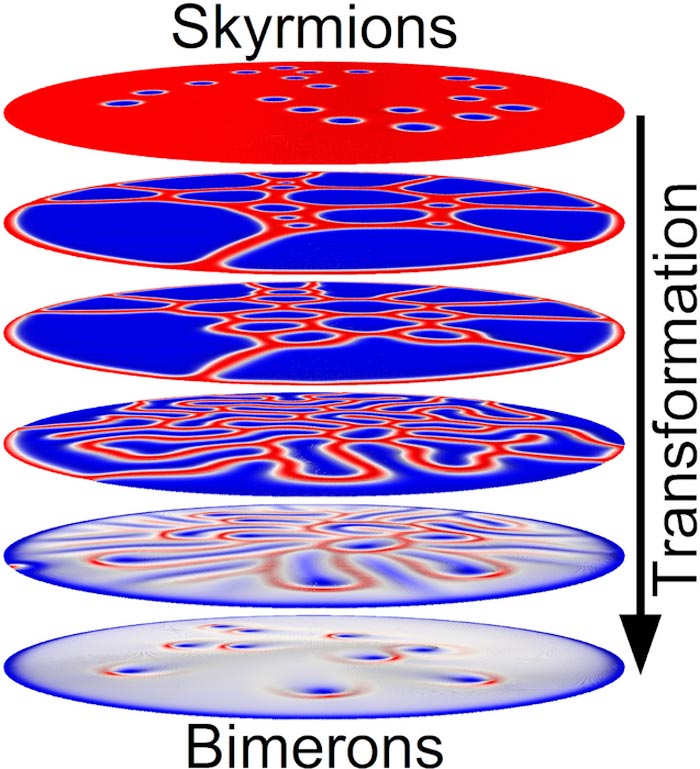The transformation between different topological spin textures

The transformation from skyrmions to bimerons in a magnetic disk, where deformed skyrmion bubbles and chiral labyrinth domains are found as nontrivial intermediate transition states. The transformation is induced by the electric current-induced Oersted field and temperature-induced perpendicular magnetic anisotropy variation.
Credit: SHINSHU UNIVERSITY
The transformation between skyrmions and bimerons has now been realized by scientists.
Skyrmions and bimerons are fundamental topological spin textures in magnetic thin films with asymmetric exchange interactions and they can be used as information carrier for next generation low energy consumption memory, advanced neuromorphic computing, and advanced quantum computing as they have multiple degrees of freedom that can carry information. The transformation between isolated skyrmions and bimerons will be an essential operation for future computing architecture based on multiple different topological bits. Therefore, it is important for the community to find effective ways to realize the creation, transformation, and manipulation of skyrmions and bimerons in magnetic materials.
In a recent study published in Nano Letters, the group led by Xiaoxi Liu, Professor in the Department of Electrical and Computer Engineering at Shinshu University in Japan and their international collaborators demonstrate in experiments and simulations that the creation of isolated skyrmions and their subsequent transformation to bimerons are possible in a magnetic disk surrounded by a current-carrying and omega-shaped microcoil, where the electric current-induced Oersted field and temperature-induced perpendicular magnetic anisotropy variation play important roles in the transformation between skyrmions and bimerons. Researchers find that the current injected into the microcoil can generate an Oersted field to switch the magnetization of the magnetic disk in the out-of-plane directions. Meanwhile, the current injected into the microcoil can heat the magnetic disk and results in the increase of the device temperature. As a result, a temperature-induced decrease of magnetic anisotropy is realized in the magnetic disk, which leads to the magnetization reorientation from the out-of-plane direction to the in-plane direction and thus, fosters the transformation from skyrmions to bimerons. Researchers also find deformed skyrmion bubbles and chiral labyrinth domains during the transformation between skyrmions and bimerons.
The researchers’ results demonstrate the possibility that two different types of topological spin textures can be hosted by a same magnetic film with asymmetric exchange interactions, which may provide guidelines for building novel spintronic applications based on different types of topological spin textures.
“Our experiment clarified for the first time the transformation between different topological spin textures,” explains Liu. He also mentions, “Skyrmions and bimerons are two most important information carriers for next generation memory and advanced computing architectures. Our research has fundamental physical interest. It is also important for future data storage and computing community”.
Researchers will try to study magnetic and spintronic device applications based on the transformation of different types of topological spin textures. An example is the voltage-gated spintronic devices based on skyrmions and bimerons. “Our ultimate goal is the application of topological spin textures for low energy consumption, high density memory and advanced neuromorphic computing.” says Liu.
This research was mainly supported by JSPS KAKENHI (Grant Nos. JP20F20363, JP21H01364, JP21K18872, and JP22F22061).
Publication:
Title: Reversible Transformation between Isolated Skyrmions and Bimerons
Authors: Kentaro Ohara, Xichao Zhang, Yinling Chen, Satoshi Kato, Jing Xia, Motohiko Ezawa, Oleg A. Tretiakov, Zhipeng Hou, Yan Zhou, Guoping Zhao, Jinbo Yang, and Xiaoxi Liu
Journal: Nano Lett. 2022, 22, 21, 8559–8566
DOI: 10.1021/acs.nanolett.2c03106
Media Inquiries:
Prof. Xiaoxi Liu
Department of Electrical and Computer Engineering
Shinshu University, Japan
Tel: +81-26-269-5480
E-mail: liu@cs.shinshu-u.ac.jp
About Shinshu University:
Shinshu University is a national university founded in 1949 located nestling under the Japanese Alps in Nagano known for its stunning natural landscapes. Our motto, “Powered by Nature – strengthening our network with society and applying nature to create innovative solutions for a better tomorrow” reflects the mission of fostering promising creative professionals and deepening the collaborative relationship with local communities, which leads up to our contribution to regional development by innovation in various fields. We’re working on providing solutions for building sustainable society through interdisciplinary research fields: material science (carbon, fiber and composites), biomedical science (for intractable diseases and preventive medicine) and mountain science, and aiming to boost research and innovation capability through collaborative projects with distinguished researchers from the world.
For more information visit https://www.shinshu-u.ac.jp/english/ or follow us on Twitter @ShinshuUni for our latest news.
Journal: Nano Letters
DOI: 10.1021/acs.nanolett.2c03106
Method of Research: Experimental study
Subject of Research: Not applicable
Article Title: Reversible Transformation between Isolated Skyrmions and Bimerons
Article Publication Date: 19-Oct-2022
COI Statement: The authors declare no competing financial interest.
Media Contact
Shiho Uehara
Shinshu University
intl_ac@shinshu-u.ac.jp
Office: 81-263-37-3569
All latest news from the category: Information Technology
Here you can find a summary of innovations in the fields of information and data processing and up-to-date developments on IT equipment and hardware.
This area covers topics such as IT services, IT architectures, IT management and telecommunications.
Newest articles

Innovative 3D printed scaffolds offer new hope for bone healing
Researchers at the Institute for Bioengineering of Catalonia have developed novel 3D printed PLA-CaP scaffolds that promote blood vessel formation, ensuring better healing and regeneration of bone tissue. Bone is…

The surprising role of gut infection in Alzheimer’s disease
ASU- and Banner Alzheimer’s Institute-led study implicates link between a common virus and the disease, which travels from the gut to the brain and may be a target for antiviral…

Molecular gardening: New enzymes discovered for protein modification pruning
How deubiquitinases USP53 and USP54 cleave long polyubiquitin chains and how the former is linked to liver disease in children. Deubiquitinases (DUBs) are enzymes used by cells to trim protein…



